I have had a love-hate relationship with foldable phones. Despite liking the form factor, I never had the confidence to use one as my primary phone. But after being among the first to get hands-on with the Samsung Galaxy Z Fold 7 in New York, my perception has changed, or rather, I have grown more fond of foldables.
I spent 30 minutes with the Galaxy Z Fold 7 during my hands-on session, and in that short time, it felt like the best book-style foldable phone I have ever used. The design is impossibly slim and light, featuring some clever AI features, and it finally looks and feels like the traditional bar-shaped flagship I have been waiting for. After a long time, I had a better time with a foldable phone.
Super slim design
As someone who has been using the Google Pixel 9 Pro Fold as a secondary device for over a year, I have a fair amount of insight into foldables. I have watched the category evolve over the years and have had access to nearly every type of foldable phone. It was the first foldable I thought looked ‘normal,’ and its shape seemed familiar. With the Galaxy Z Fold 7, Samsung took a similar approach by creating a book-style phone with a bar-like shape, though the Pixel Fold is more compact in size. I think it’s a different approach to making a foldable phone and has a lot to do with bringing the Galaxy Z Fold 7 closer to Samsung’s Galaxy S25 Ultra, and it shows.
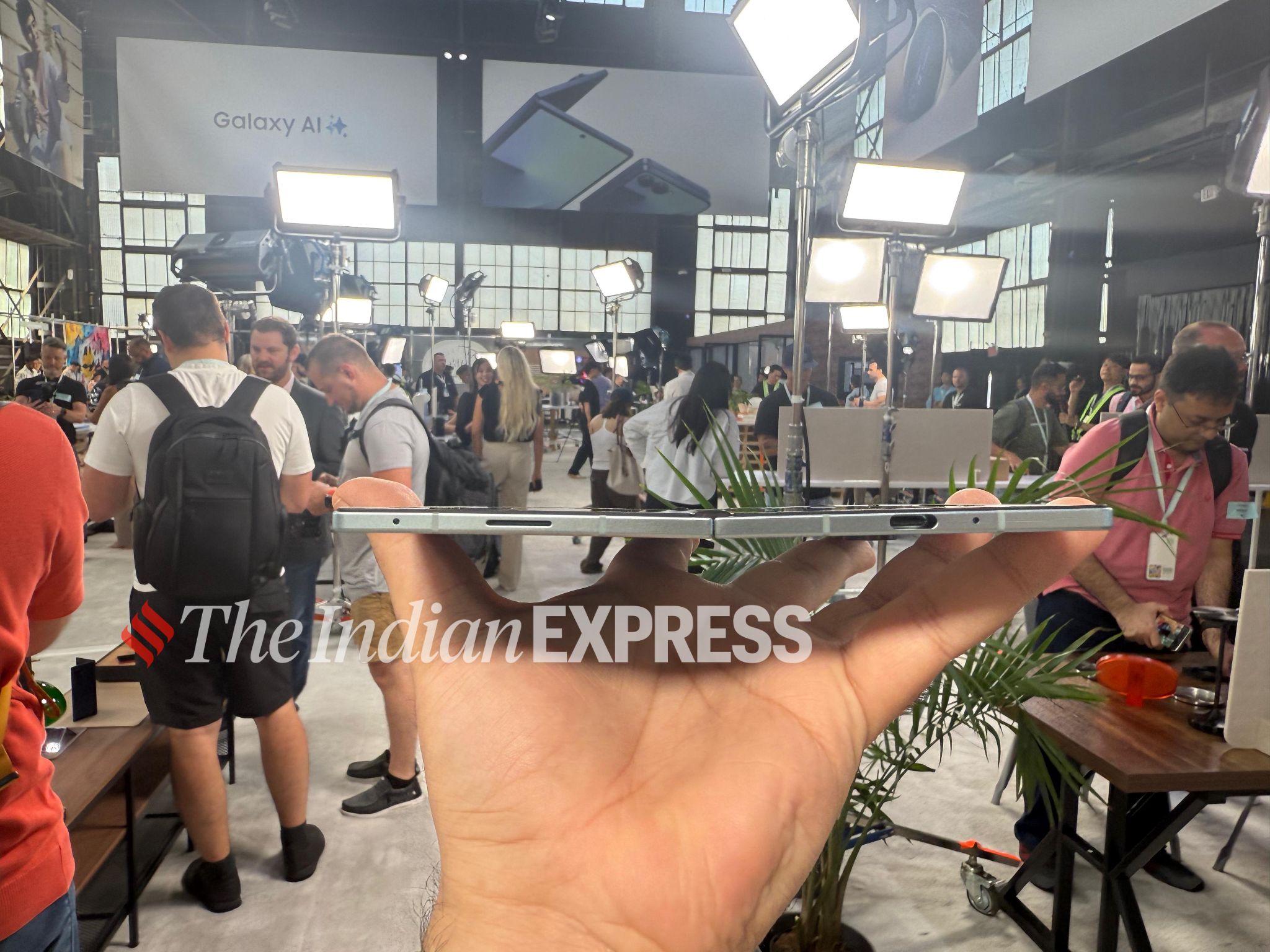 The phone has squarer edges and feels more airy (weighing only 215 grams. (Image: Anuj Bhatia/The Indian Express)
The phone has squarer edges and feels more airy (weighing only 215 grams. (Image: Anuj Bhatia/The Indian Express)
The Galaxy Z Fold 7 is the slimmest folding phone I have tried, and the one that’s launching in global markets, including India. It is 8.9 mm thick when folded and 4.2 mm when open. To put that into context, the Samsung Galaxy Z Fold 6 is 12.1 mm when folded, and 5.6 mm when open, while the Pixel 9 Pro Fold is 10.5 mm folded and 5.1 mm open. Only the Honor Magic V5 is slimmer at 8.8 mm, though that device has a raised camera bar and is limited to certain markets.
But Samsung did a good job making the Galaxy Z Fold 7 feel closer to a regular high-end flagship device. The phone has squarer edges and feels more airy (weighing only 215 gram), making it easy to pick up and hold when folded. You can use it like a regular 6.5-inch phone and go about your day until you need the expansive 8-inch tablet screen on the inside. These may seem like minor changes at first, but when you hold the phone and start using it, the differences become noticeable. While the previous generation Galaxy Z Fold 6 weighs 239 gram, the Pixel 9 Pro Fold comes in at 257 grams. Even the iPhone 16 Pro, which is a non-folding phone, weighs 239 grams.

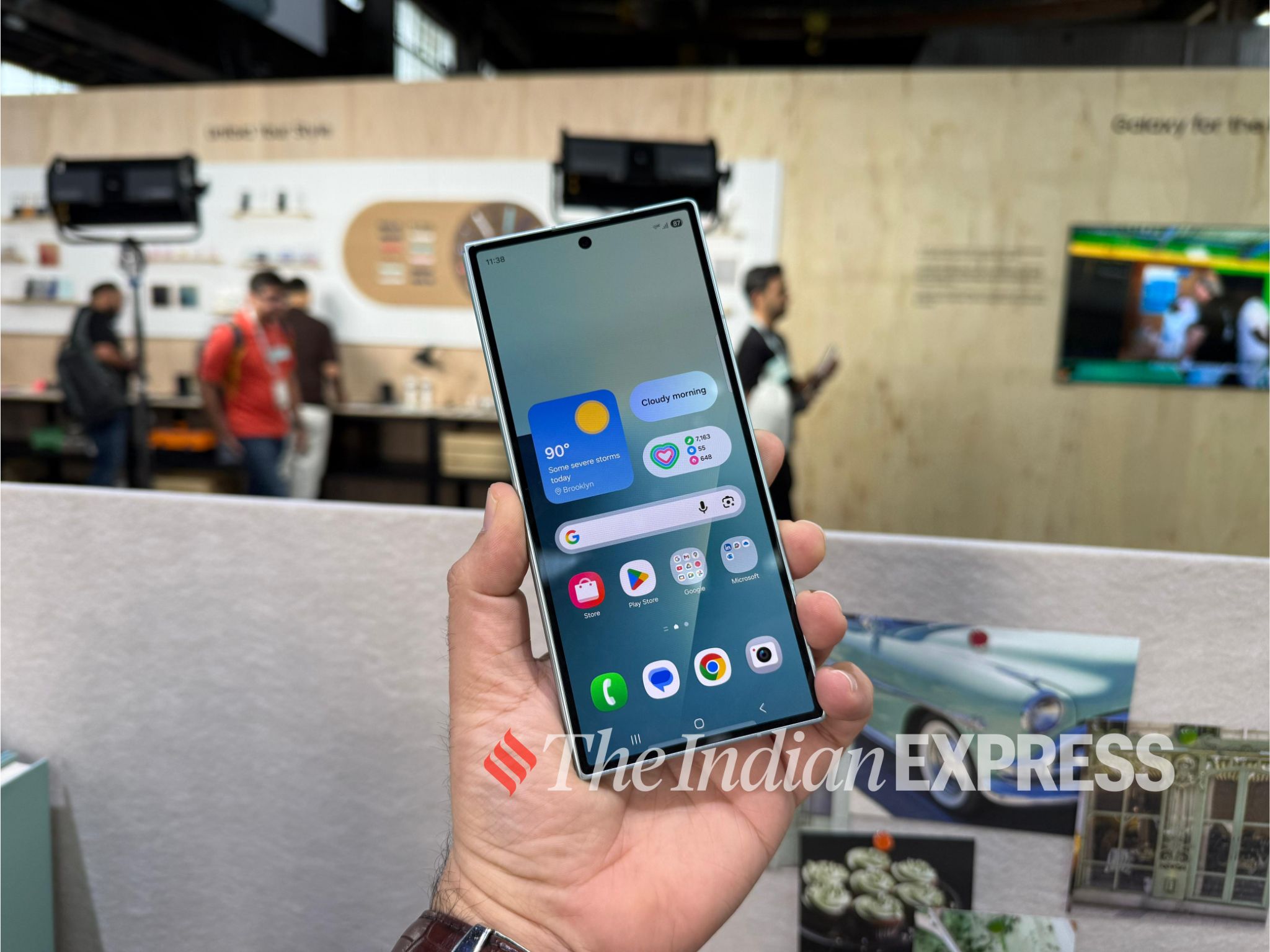 The Galaxy Z Fold 7 has a bright 6.5-inch outer screen and opens to reveal an 8-inch inner screen. (Image: Anuj Bhatia/The Indian Express)
The Galaxy Z Fold 7 has a bright 6.5-inch outer screen and opens to reveal an 8-inch inner screen. (Image: Anuj Bhatia/The Indian Express)
Not only does the Galaxy Z Fold 7 feel extremely lightweight and slimmed down, but Samsung also claims the device is more durable and built to last longer. It features an Armor Flex Hinge, which is thinner and lighter thanks to an improved water droplet design, and even the cover display is made of Corning Gorilla Glass Ceramic 2. Moreover, Samsung has used advanced Armor Aluminum in the frame and hinge to strengthen the housing, while the use of ultra-thin glass was increased by 50 per cent, making the display tougher. The Galaxy Z Fold 7 also scores an IP48 rating, offering much better protection against elements like dust and liquids.
I can’t speak about the accuracy of those claims. Having said that, durability is the biggest concern for consumers, especially in the case of foldables, and it takes both time and trust for foldables to match the durability standards set by traditional phones.
Story continues below this ad
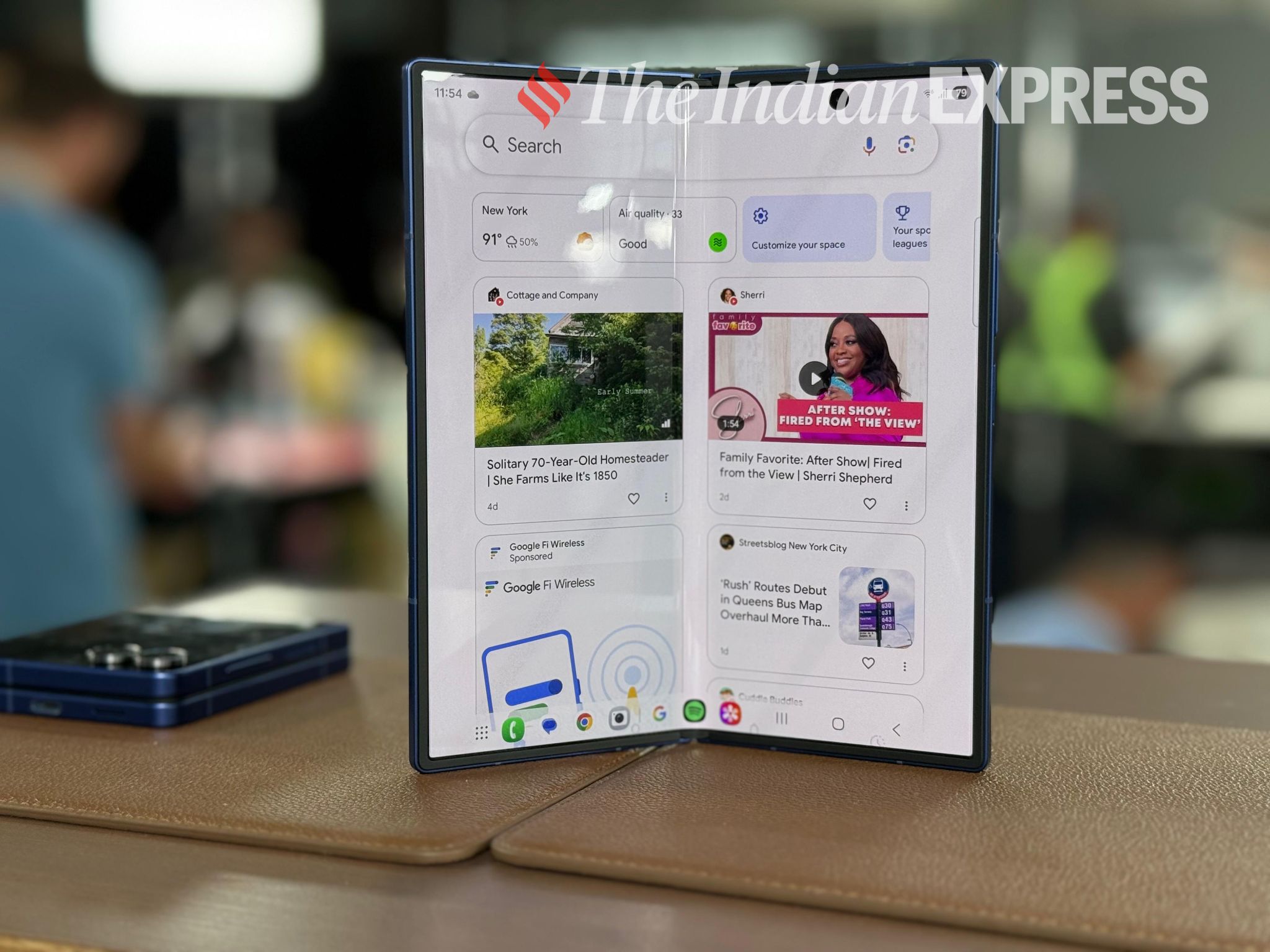 Samsung is using a 4,400mAh dual battery. (Image: Anuj Bhatia/The Indian Express)
Samsung is using a 4,400mAh dual battery. (Image: Anuj Bhatia/The Indian Express)
The Galaxy Z Fold 7 has a bright 6.5-inch outer screen and opens to reveal an 8-inch inner screen. Both have a dynamic refresh rate that goes up to 120 Hz but drops when appropriate to save battery life. Both displays are sharp and vivid, making them suitable for reading, gaming, or watching videos.
The shape of the inner screen makes it suitable for using two apps side by side and is well-suited to widescreen video. The crease necessary to allow the screen to fold in the middle is less noticeable than in previous versions, but it is still a compromise common to all folding displays, alongside their softer, less durable materials.
Inside, the Galaxy Z Fold 7 runs what Samsung calls a customised Snapdragon 8 Elite processor coupled with 12 GB of RAM (the top model comes with 16 GB of RAM and 1 TB storage). The Elite is Qualcomm’s flagship processor, and Samsung claims a 41 per cent faster NPU, 38 per cent faster CPU, and 26 per cent faster GPU. Battery life should be better than in previous versions. Samsung is using a 4,400mAh dual battery, although I will reserve my verdict until after extensive testing of the device. When you need to top up, you can plug in and use a 25W adapter, enough to fully charge the Galaxy Z Fold 7 in under an hour. Fast wireless charging and wireless power share are also supported.
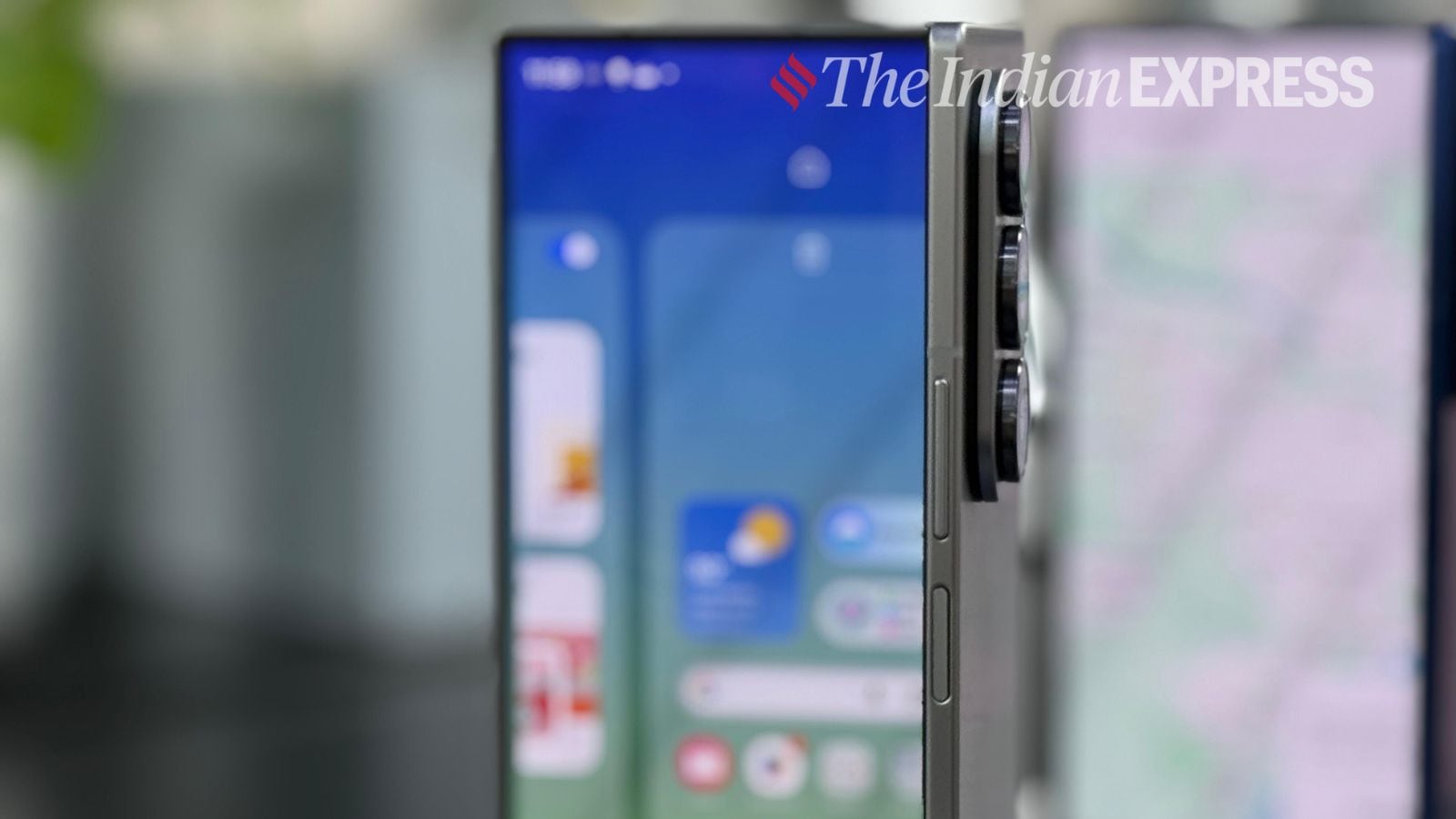 The Samsung Galaxy Z Fold 7 is 8.9 mm thick when folded and 4.2 mm when open. (Image: Anuj Bhatia/The Indian Express)
The Samsung Galaxy Z Fold 7 is 8.9 mm thick when folded and 4.2 mm when open. (Image: Anuj Bhatia/The Indian Express)
The camera improvements on the Galaxy Z Fold 7 are significant, as Samsung claims. You are getting a 200MP primary camera with an impressive Space Zoom, a 10MP telephoto lens, and a 12MP ultra-wide camera. I briefly tried the camera, but it was in a controlled demo centre, which always makes it difficult to truly judge its performance. I’ll be reviewing the phone soon, and I am particularly interested in how good the camera is. Typically, phone makers ship foldables with cameras that are a step below those found in their traditional flagship devices. Hopefully, that changes with the Galaxy Z Fold 7.
Story continues below this ad
The software and AI features
Optimisation for the larger screen is a big part of the Galaxy Z Fold 7 and Samsung’s One UI 8, which ships with the device. Samsung emphasised its AI agents’ “cross-app” capabilities. Google’s Gemini is deeply integrated, something we already saw with the Galaxy S25 series. This time, Gemini Live’s feature, which allows it to see and respond to what’s on your camera, is being promoted as a standout feature.
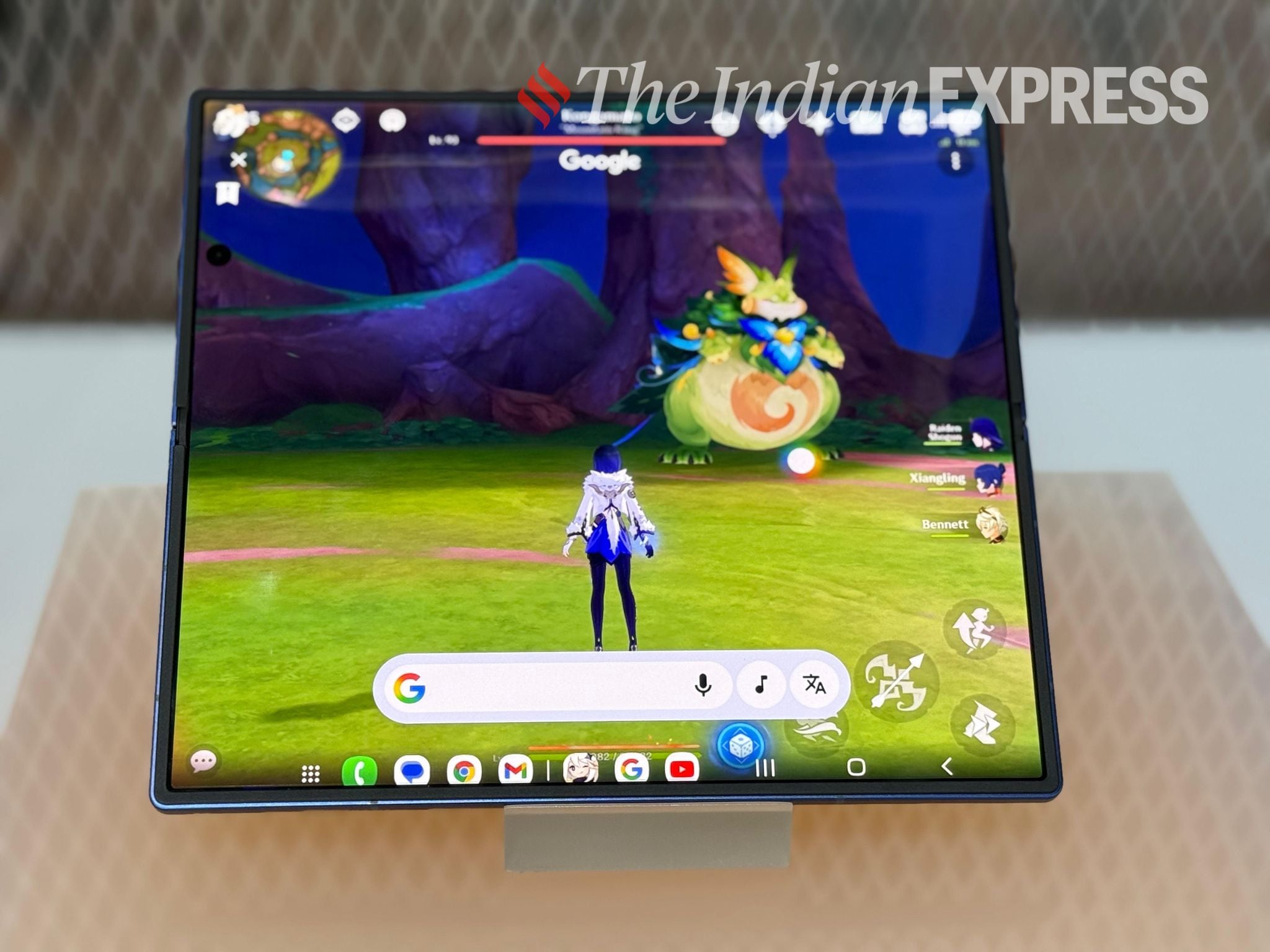 Both displays are sharp and vivid, making them good enough for reading, playing games, or watching videos. (Image: Anuj Bhatia/The Indian Express)
Both displays are sharp and vivid, making them good enough for reading, playing games, or watching videos. (Image: Anuj Bhatia/The Indian Express)
The Circle to Search feature is included as well, and it now works within games, letting users circle an item, and get instant results. Now Bar, the AI feature first introduced in the Galaxy S25 series and inspired by Apple’s Dynamic Island, is also coming to the new Galaxy foldables. New to the Galaxy Z Fold 7 is Results View, which displays results from AI features in a separate split view or as a floating window. Users can now drag and drop AI-generated content—including images and text directly from Multi Window. The device ships with Android 16 support and seven years of software support, matching Google.
One thing I didn’t like about the Galaxy Z Fold 7 is the lack of support for the S Pen. It’s puzzling to see why the S Pen, once a marquee feature, is no longer part of the Galaxy Z Fold 7 in any form. I think the S Pen makes a lot of sense on a device like the Galaxy Z Fold 7, especially now, when it could be even more useful on an 8-inch screen. With Samsung doubling down on multitasking features and going all-in on AI, the absence of the S Pen feels like a missed opportunity.
Early impressions
Versatility is the biggest appeal of foldables, and it’s something you need to experience firsthand to truly understand the kind of devices they are. The Galaxy Z Fold 7 offers a range of productivity advantages that regular slab phones simply can’t match.
Story continues below this ad
With better durability and improved cameras, a foldable device like the Galaxy Z Fold 7 offers more screen real estate, making it perfect for a larger on-screen keyboard and enough space to use apps like Lightroom or real-time translation without feeling cramped.
That said, the price of the Galaxy Z Fold 7 at $2,000, means it’s unlikely to appeal to mainstream consumers. It remains a luxury smartphone, but I can see the Galaxy Z Fold 7 earning a place somewhere between conventional smartphones and tablets.



